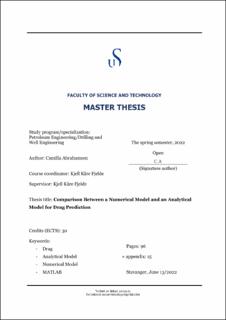Comparison Between a Numerical Model and an Analytical Model for Drag Prediction
Master thesis
Permanent lenke
https://hdl.handle.net/11250/3020980Utgivelsesdato
2022Metadata
Vis full innførselSamlinger
- Studentoppgaver (TN-IEP) [329]
Sammendrag
High torque and drag create problems in directional wells. Directional wells have increased in inclination and length over the years, whereas the extended reach wells (ERW) are particularly prone to torque and drag limitations. Using friction models during well planning, drilling, and completion of the well will ease these issues by predicting and preventing problems at an early stage.
In this thesis, an analytical model, and a numerical model for drag prediction will be compared. Normally, the normal force consists of two components. One component is due to weight, and another component is due to tension effects (Capstan effect). In the numerical model, the normal force contribution due to the weight component perpendicular to the pipe axis is taken into consideration. The analytical model has been simplified where this term is neglected.
When comparing the models, results show that the models calculate equally for both straight inclined sections and vertical sections. The deviation between the models is within curved sections, as the friction in curved sections is modeled differently. The models increase in difference when having a large friction coefficient. A large friction coefficient increases the tension effect (Capstan effect) within a bend. The Capstan effect also increases as the bottom force increases. However, the difference between the models is maybe not very large when one takes into account that the friction coefficient is a calibration factor that can change the model results more than maybe the choice of the model.
The analytical model was implemented in Excel while the numerical model was implemented in MATLAB. More details can be found in the appendix.
